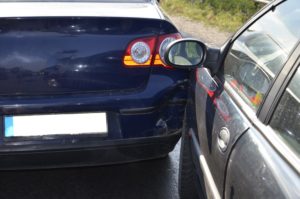Many types of collisions come out of the blue. Sideswipe collisions, however, may prove particularly difficult to predict and avoid since they often occur between vehicles traveling in the same direction, and the driver of the car hit may not recognize the presence of danger until the accident occurs. Do you know what a sideswipe collision looks like and how to handle these common auto accidents?
Sideswipe collisions have a reputation as a relatively minor motor vehicle accident. In truth, these crashes can cause severe damage and catastrophic injury. In this blog post, we examine sideswipe collisions in detail: how they occur, what you can do to keep yourself safe from one, and how an attorney can help if a sideswipe collision injures you or a loved one.
For more information about your legal rights, contact an experienced car accident lawyer Bronx today.
What Is a Sideswipe Collision?
A sideswipe collision occurs when one vehicle hits, or “swipes,” another vehicle indirectly along its side. Sideswipe collisions often occur between vehicles traveling in the same traffic lane or between vehicles traveling in parallel lanes of traffic. A sideswipe collision generally does not involve a straight-on hit between two vehicles but rather glancing or “swiping” damage.
Why Do Sideswipe Collisions Occur?
Sideswipe collisions may occur due to several common challenges that people might face on the road every day. Most involve the negligence of at least one other driver.
Merging Incidents
Merging accidents are responsible for a large number of sideswipe collisions. Merging incidents may occur when one vehicle attempts to merge onto a highway or interstate but does not have adequate room to make it into the lane.
Often, merging incidents occur because the drivers already in the traffic lane fail to allow adequate room for other vehicles to merge. They also may occur because the merging driver tries to merge too early or tries to force the vehicle in instead of giving the other vehicles time to make room. Merging incidents often occur at high rates of speed, which means they can cause considerable damage to both vehicles and substantial injury to the people in them.
Lane-Change Accidents
Changing lanes can prove fraught with danger for some drivers, especially if they do not look twice to ensure they have adequate room to change lanes. Lane change incidents may occur either because the lane-changing driver does not make sure he has adequate room before moving over or because the drivers in the other lane do not provide the room needed to change lanes. The driver who attempts to merge will be liable for a sideswipe collision resulting from an unsafe lane change.
Driving While Distracted
Distracted driving occurs when a driver takes their eyes, hands, or attention off the road. Distracted driving can involve cell phone use, which many states ban outright or heavily regulate. However, other forms of distraction can prove equally problematic, including eating or drinking behind the wheel, putting on makeup, and more.
Distracted drivers may lose focus on the road, causing them to drift out of their assigned lanes of traffic. A distracted driver may have difficulty keeping up with everything around them, increasing the risk of swiping another driver.
Inebriated Driving
Drivers who choose to get behind the wheel while under the influence of drugs or alcohol may not be able to control their vehicles safely. Drunk drivers often lose motor control and visual skills, increasing the risk that those drivers will end up involved in a collision. Drunk drivers may also find it much more difficult to keep up with the flow of traffic or to navigate safely, increasing the risk that they will cause a sideswipe collision.
Drowsy Driving
Drowsy drivers may experience some of the same general symptoms as inebriated drivers. Drowsy drivers often have difficulty keeping their vehicles in their assigned lanes. In extreme cases, drowsy drivers may fall asleep behind the wheel altogether. When a driver drifts off, the vehicle is completely uncontrolled.
The vehicle may then drift into another lane or even cause a more extreme accident, depending on the traffic flow and the vehicle’s position on the road. While drowsy drivers may wake up when an accident occurs, they likely have no time to react to the potential dangers or decrease the risk or damage of an accident.
Blind Spot Accidents
Some drivers may end up causing a devastating collision due to large vehicle blind spots. All vehicles have blind spots: areas outside the vehicle where the driver cannot see clearly. Large vehicles typically have even larger blind spots, creating increased risks of accidents. Big trucks, for example, have large blind spots on every side of the vehicle. Most drivers know they must check their blind spots carefully before changing lanes. However, in some cases, drivers may lose track of traffic around them, resulting in a blind spot collision.
What to Do After a Sideswipe Collision?

In some cases, sideswipe collisions may cause comparatively little property damage, with no injury to anyone in the vehicle. In other cases, however, sideswipe collisions cause substantial property damage and massive injuries to everyone in the vehicle.
What should you do next?
The first steps after a car accident involve checking everyone for injury and getting medical treatment if needed. However, the steps you take after the accident can significantly affect your financial position and the compensation you can recover after the accident. What should you do next?
1. Always report any accident involving property damage to the police.
Even if you have only minor scrapes to your vehicle, it is wise to report the accident. If you note significant damage to the vehicle or if anyone suffers an injury, you should certainly report the incident to the police. Failure to report an accident could make getting compensation for your preventable injuries and losses more difficult.
2. Have a medical care provider look you over to ensure all your injuries are accounted for and treated
Sideswipe collisions can range from relatively minor to very serious. If you have any questions about whether you may have an injury, always have a medical care provider look you over. The more serious the collision, the higher the risk that you suffered some injury in the accident, and the more carefully you should proceed.
3. Keep track of all medical bills associated with your sideswipe accident.
After an accident, especially if you suffered significant preventable injuries, it does not take long for your medical bills to pile up.
In many cases, you may worry about taking care of these bills.
Keep track of them, including:
- Any bills paid by PIP coverage. In some states, including New York and New Jersey, personal injury protection coverage will kick in regardless of who caused the accident. You want to make sure that you track what your PIP coverage paid.
- Any co-pay or deductible amounts you have to cover.
- Any bills you receive from your medical care provider.
Keep a record of all costs associated with treatment. If you can provide your treatment cost records to your lawyer, they can use them to demonstrate the compensation you deserve for your injuries.
4. Listen to your medical care provider’s instructions and follow them.
When you suffer preventable injuries in an accident, your medical care provider will likely offer you a comprehensive list of instructions to follow to maximize your odds of a full recovery. You may feel frustrated by those instructions, especially regarding limitations on your usual activities.
However, you should follow those instructions carefully.
- First, your medical care provider issues those instructions to help you recover from the accident, not to frustrate or limit you. Failure to follow those instructions could limit or reduce your recovery.
- Second, failing to follow your medical care provider’s instructions could prevent you from recovering the full compensation you might otherwise deserve for your injuries. Insurers may suggest you worsened your injuries by not following the doctor’s instructions and therefore do not deserve as much compensation.
5. Get a copy of the police report from the sideswipe collision.
Any time you suffer preventable injuries in an accident and need to file an injury claim, go over the police report to ensure that it accurately reflects what led to the accident.
Look at:
- The date and time of the accident
- The location of the accident
- Any details about the accident included in the report
If you notice inaccuracies, contact the police department for a review of the police report. You need an accurate police report describing what led to your accident to help support your claim.
6. Avoid talking to the insurance company on your own.
After a sideswipe collision, you may need to speak with the liable party’s insurance company to get coverage for your accident and injuries. The insurance company could try to get out of paying you any more than absolutely necessary.
You might, for example, get a low settlement offer from the insurance company that they pressure you to accept quickly, or the insurance company may try to claim that you contributed in some way to the accident. Avoid talking to the insurance company directly since it could ultimately limit the compensation you recover.
7. Contact a lawyer as soon after your accident as possible.
A lawyer can offer many essential benefits as you navigate a sideswipe collision. Your lawyer can help you determine what compensation you deserve, collect evidence about your accident, and fight for your compensation from the insurance company.
Do not try to handle your claim alone, as you could leave essential compensation on the table. Instead, let your lawyer handle the claim and negotiations on your behalf.
Recovering Compensation After a Sideswipe Collision: What to Expect
Many factors can determine the compensation you recover for a sideswipe collision, including the insurance company that covers the liable party and whether the liable party denies fault for the accident. By working with a lawyer, you can demonstrate the losses you suffered from the accident and the compensation you expect.
Compensation may include:
- Compensation for any medical costs associated with the accident. Sideswipe collisions can lead to high medical bills, especially for injuries to the person on the damaged side of the vehicle. Talk to your lawyer about the medical bills you have already faced and any future medical expenses you might expect.
- Compensation for any income losses associated with the accident.
- Compensation for any suffering you faced from your injuries.
The insurance company may make recovering compensation more difficult than you anticipate. Talk to a lawyer to get a better idea of how your claim might proceed, including how to establish liability for the accident and increase the odds that you will recover reasonable compensation for your losses.
Contact a Lawyer for Help with Your Sideswipe Collision Claim

Car Accident Lawyer, Andrew Finkelstein
If you suffered injuries in a sideswipe collision, trying to handle that claim yourself can make it difficult to recover the compensation you deserve.
A lawyer can:
- Review your claim to give you a better idea of how much compensation you should expect for the injuries you sustained in the accident.
- Collect much-needed evidence that will aid in establishing who caused the sideswipe collision, including a search for any additional parties that may have contributed to the incident.
- Deal with the insurance company for your. Frequently, having a lawyer to communicate and negotiate with the insurance company not only increases the compensation you recover but may decrease the stress you experience as you navigate your claim and heal from injuries.
Did you suffer injuries in a sideswipe collision? Contact an attorney right away for a free case evaluation. An experienced car accident attorney can help you learn more about your rights and explain how they can help you pursue the compensation you deserve.
